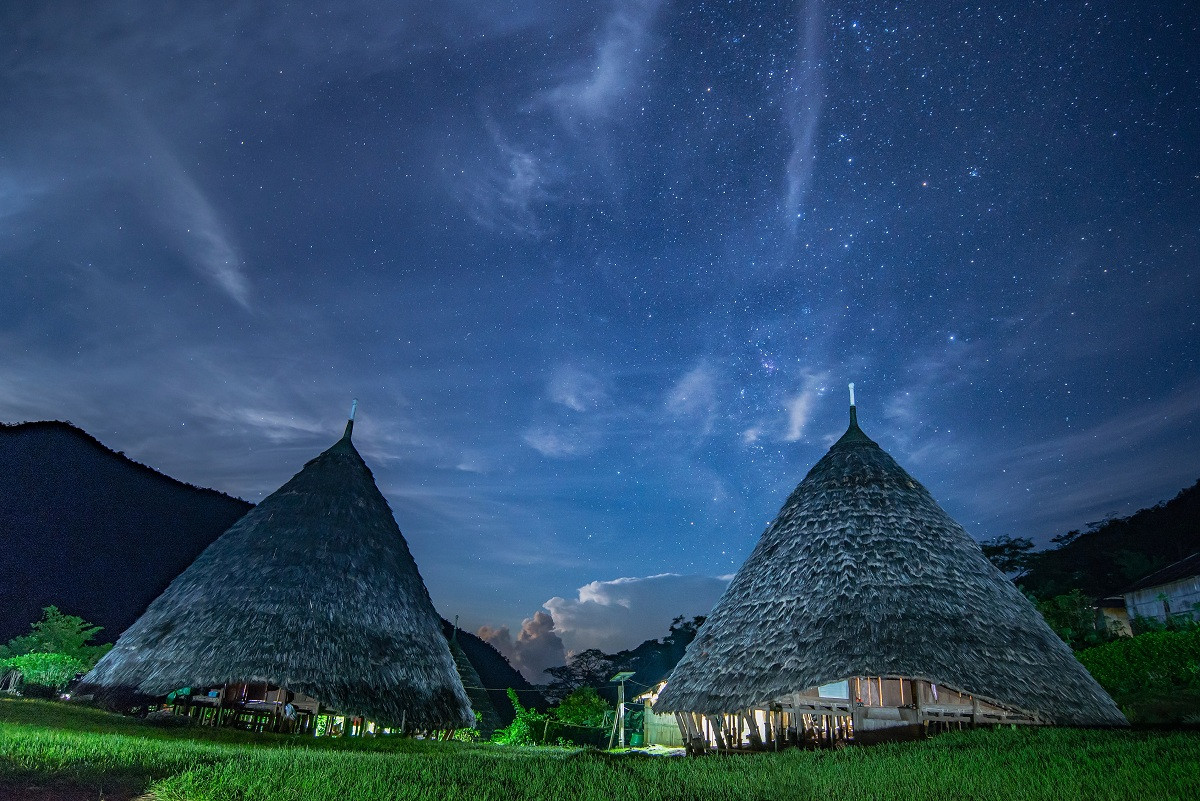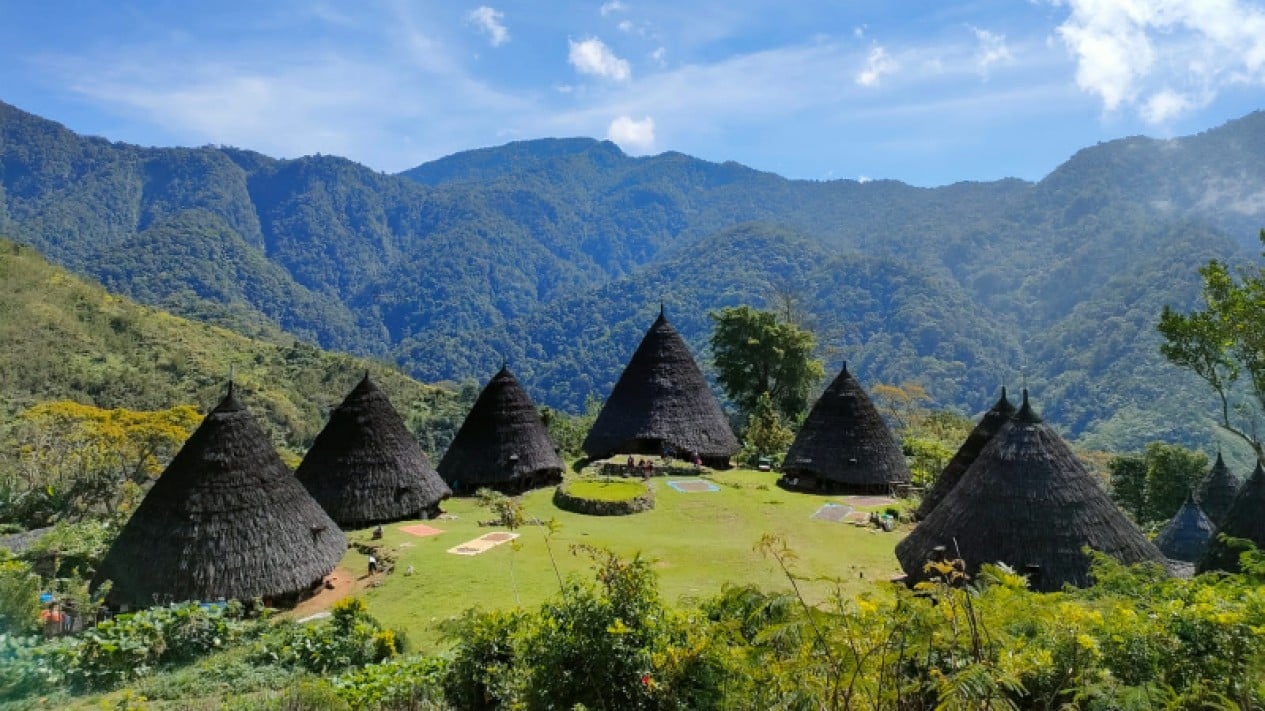Indonesia not only boasts natural beauty but also a rich cultural heritage passed down by its ancestors. Amidst the onslaught of modernization, many villages in remote areas continue to uphold the traditions passed down through generations. One such village is Wae Rebo, located near Labuan Bajo, Manggarai Barat, East Nusa Tenggara. Despite being isolated from the outside world, it is precisely this isolation that makes this traditional village a major attraction. If you’re vacationing in Labuan Bajo and planning to continue your adventure here, check out these 7 fascinating facts about Wae Rebo Village.
Your itinerary

1. One of the Highest Villages in Indonesia
There’s a reason Wae Rebo is called "The Land Above the Clouds." The village is situated in a valley at an altitude of around 1,088 meters above sea level. Surrounded by lush green hills, the cold air cuts through your skin when night falls, and a light mist always envelops the village in the morning. Wae Rebo is far from the hustle and bustle of the city, making every moment feel peaceful and serene.
2. Home to Seven Main Houses
Wae Rebo is only inhabited by seven main houses known as Mbaru Niang. These conical-shaped houses are built in five levels, with thatched roofs made from lontar leaves and covered with palm fiber. The structure reaches about 15 meters high, and each level serves a specific function. The ground floor is the living space, the second floor stores food and daily essentials, and the third floor is used for storing plant seeds. The fourth level holds food supplies, and the topmost level is reserved for offerings to ancestors. Each house can accommodate six to eight families. Can you imagine how spacious it is?
3. A Long Journey to Get There
Although part of the same region as Labuan Bajo, reaching Wae Rebo requires a long journey. From Labuan Bajo to Denge, the nearest village to Wae Rebo, it takes about five hours. From Denge, you’ll travel further along steep mountain roads. The motorbike ride can only go up to the first checkpoint. After that, you must walk for about three hours along a challenging path with inclines, sometimes flat, and next to steep cliffs. Exciting, right? It's best to hire a guide to make your journey to Wae Rebo more enjoyable.
4. Don’t Miss the Elder’s House Visit
Once you arrive in Wae Rebo, you will be taken to the main house, Niang Gendang. Here, the village chief will invite you to participate in the Waelu’u ceremony, a ritual seeking permission from the ancestors of Wae Rebo. Guests will also be treated to fragrant Flores coffee. It’s a good idea to spend the night here to blend in and immerse yourself in the life of the Wae Rebo community, where local wisdom is still cherished..
5. The People of Wae Rebo Are Descendants of the Minangkabau
Although Wae Rebo is located in East Nusa Tenggara, its inhabitants claim to be descendants of the Minangkabau people from West Sumatra. It was Empo Maro, the ancestor of the Wae Rebo people, who originally came from Minangkabau. He migrated to Flores and eventually settled in this village. Despite this, the residents of Wae Rebo do not carry any Minangkabau names.
6. The Penti Ceremony, A Special Day for the People of Wae Rebo
If you have the opportunity to choose when to visit, try to come when the people of Wae Rebo are celebrating the Penti ceremony. This annual traditional ritual is held to mark the New Year for the Manggarai people. On this special day, the villagers express gratitude and offer sacrifices to their ancestors for the blessings received in the past year. They also pray for prosperity in the coming year. The ritual of purifying the village and its people is performed to ward off evil spirits.
7. A UNESCO World Heritage Site
The beauty of Wae Rebo has reached the world stage. Surrounded by breathtaking landscapes, the village's rich cultural heritage continues to attract tourists who wish to experience its traditional way of life. In 2012, Wae Rebo was added to the UNESCO World Heritage list, making it a UNESCO Cultural Heritage Conservation site. Even the Mbaru Niang house structure received the prestigious Aga Khan Award for Architecture. Amazing! These are the 7 facts about Wae Rebo Village that you must include in your travel itinerary when visiting Labuan Bajo. Ready to admire Wae Rebo’s beauty up close?

1. One of the Highest Villages in Indonesia
There’s a reason Wae Rebo is called "The Land Above the Clouds." The village is situated in a valley at an altitude of around 1,088 meters above sea level. Surrounded by lush green hills, the cold air cuts through your skin when night falls, and a light mist always envelops the village in the morning. Wae Rebo is far from the hustle and bustle of the city, making every moment feel peaceful and serene.
2. Home to Seven Main Houses
Wae Rebo is only inhabited by seven main houses known as Mbaru Niang. These conical-shaped houses are built in five levels, with thatched roofs made from lontar leaves and covered with palm fiber. The structure reaches about 15 meters high, and each level serves a specific function. The ground floor is the living space, the second floor stores food and daily essentials, and the third floor is used for storing plant seeds. The fourth level holds food supplies, and the topmost level is reserved for offerings to ancestors. Each house can accommodate six to eight families. Can you imagine how spacious it is?
3. A Long Journey to Get There
Although part of the same region as Labuan Bajo, reaching Wae Rebo requires a long journey. From Labuan Bajo to Denge, the nearest village to Wae Rebo, it takes about five hours. From Denge, you’ll travel further along steep mountain roads. The motorbike ride can only go up to the first checkpoint. After that, you must walk for about three hours along a challenging path with inclines, sometimes flat, and next to steep cliffs. Exciting, right? It's best to hire a guide to make your journey to Wae Rebo more enjoyable.
4. Don’t Miss the Elder’s House Visit
Once you arrive in Wae Rebo, you will be taken to the main house, Niang Gendang. Here, the village chief will invite you to participate in the Waelu’u ceremony, a ritual seeking permission from the ancestors of Wae Rebo. Guests will also be treated to fragrant Flores coffee. It’s a good idea to spend the night here to blend in and immerse yourself in the life of the Wae Rebo community, where local wisdom is still cherished..
5. The People of Wae Rebo Are Descendants of the Minangkabau
Although Wae Rebo is located in East Nusa Tenggara, its inhabitants claim to be descendants of the Minangkabau people from West Sumatra. It was Empo Maro, the ancestor of the Wae Rebo people, who originally came from Minangkabau. He migrated to Flores and eventually settled in this village. Despite this, the residents of Wae Rebo do not carry any Minangkabau names.
6. The Penti Ceremony, A Special Day for the People of Wae Rebo
If you have the opportunity to choose when to visit, try to come when the people of Wae Rebo are celebrating the Penti ceremony. This annual traditional ritual is held to mark the New Year for the Manggarai people. On this special day, the villagers express gratitude and offer sacrifices to their ancestors for the blessings received in the past year. They also pray for prosperity in the coming year. The ritual of purifying the village and its people is performed to ward off evil spirits.
7. A UNESCO World Heritage Site
The beauty of Wae Rebo has reached the world stage. Surrounded by breathtaking landscapes, the village's rich cultural heritage continues to attract tourists who wish to experience its traditional way of life. In 2012, Wae Rebo was added to the UNESCO World Heritage list, making it a UNESCO Cultural Heritage Conservation site. Even the Mbaru Niang house structure received the prestigious Aga Khan Award for Architecture. Amazing! These are the 7 facts about Wae Rebo Village that you must include in your travel itinerary when visiting Labuan Bajo. Ready to admire Wae Rebo’s beauty up close?




